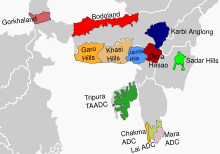Hill tribes of Northeast India
In response to attempts by the Assamese majority in the plains to impose their language, the hill people began to struggle for yet more autonomy as separate states within the Indian Union, which they largely achieved.At the time of Indian Independence from British Rule in 1947, the Northeastern region consisted of Assam and the princely states of Manipur and Tripura.[4] Before the British arrived the hill tribes traded with the plains people of the Ahom kingdom in the Brahmaputra River Valley, but periodically fought with them.[6] Writing about the broader area of mountainous parts of Southeast Asia that he calls "Zomia", Professor James C. Scott argues in The Art of Not Being Governed (2009) that while valley people see hill people as backward, "our living ancestors", they may be better understood as "runaway, fugitive, maroon communities who have, over the course of two millennia, been fleeing the oppressions of state-making projects in the valleys".Elliot, chief commissioner of Assam, wrote in 1881, "the more I thought about it ... the less practicable it seems to try to restrain the Nagas with their wanderings and trading habits, within an imaginary line which they have always been accustomed to cross.Yet, though it lies between two fertile, populous provinces, with their railways, roads, and steamers services, it is as yet largely unexplored and contains some of the most primitive tribes to be found within our Indian Empire.[14] Furer-Haimendorf (1945) saw the occasional uprisings of the frontier tribes against the British as "more in the nature of resistance to the establishment of Government's authority than a challenge to the administration."[14] The separation of Burma in 1937 and partition of British India in 1947 divided many tribal groups such as the Garo, Khasi, Kom, Mara, Kuki, Zomi, Mizo and Naga across international borders.But Indians such as Rohini Kumar Chaudhuri wanted them to be part of a unified state of Assam so they could be assimilated into the plains culture.[17] The Sixth Schedule of the Constitution of India provides for tribal areas in Assam, Meghalaya, Tripura and Mizoram to be administered as autonomous districts or regions.[17] The Naga leader Angami Zapu Phizo did not participate in the Hill State movement since he was pursuing independence for Nagaland alone."[25] Pugh went on to argue that a single large hill state comprising what is now Meghalaya, Nagaland, Arunachal, Mizoram and the districts of Mikir and North Cachar Hills would have been much more viable than the mini-states that were in fact created, the separatist movements would not have developed and the tribal people would have become psychologically and culturally integrated with the rest of India sooner.[29] Various attempts were made to resolve the often-violent struggles between the state and the hill tribes through accords, with varying degrees of success.[32] Most peace accords guarantee cultural rights and include provisions for the rebels to disarm and receive assistance in returning to civilian life.Often the surrender and disarmament have been incomplete, while the guarantees of cultural rights have not been fully implemented due to the inter-tribal conflicts and having the potential to harm other groups.[35] Pointing to the Bengali dominance in Tripura as an example, the tribal leaders of the other hill states demand restrictions on activities of non-tribal people as allowed under the Sixth Schedule.[45] Shifting cultivation, known as adiabik in Arunachal Pradesh and jhoom in Assam and Tripura, is an ancient method of farming in the tropics and subtropics.[47] However studies in the Philippines, Africa and India have shown that jhooming can only support about 6 people per 1 square kilometre (0.39 sq mi).[51] The land is cleared apart from a few large trees, which are thinned, and the cut vegetation is spread out to dry, protecting the soil during this period.The community social structure had broken down, and the younger people had become involved in commercial, sometime illegal, exploitation of forest resources.[55] Some efforts have been made to resettle jhumias on the plains, or to help them adapt to working on coffee, black pepper, rubber, betel, kathal and orange plantations.[60] The term Mizo is used to define an overall ethnicity, and covers various related peoples who claim descent from Sinlung, a mythical rock north of the Shan State of Myanmar.[22] During the famine of 1958–59 the Indian state failed to provide aid to the hill people, and this neglect led to the Mizo armed uprising.However the many non-Lushai groups were overlooked in the Mizo Accord, and the Brus and Hmars began to demand autonomous district or regional councils.The Nagas want reassurance that oil extraction will not damage the environment, and that if they are forced to relocate they will receive land as well as money in compensation.It borders Assam and Nagaland to the south, Bhutan in the west, Myanmar in the east and is separated from China in the north by the McMahon Line.[citation needed] Arunachal Pradesh was formed from the frontier tracts as an administrative convenience, with much less political activity by the people than elsewhere in the northeast.[83] After the partition of India most of the Hindu Bengalis of the princely state moved to the Indian area of the Tripura hills, where they settled in lands used for shifting cultivation by the tribal people, and came to dominate politics.[85] Shibani Kinkar Chaube wrote of Tripura in 1975, "After partition Bengalis have far outnumbered the tribals, who are in a miserable stage of battle for survival, expressed through occasional violence and leftist politics.Crops include rice, maize, tea, soybean, ginger, orange, pears, potato, tomato and cardamoms.
















Naga woman
Koirenghill peopleScheduled TribesNortheast IndiaTibeto-BurmanSino-TibetanBritish IndiaIndian independenceBrahmaputra RiverBarak RiverHimalayasGaro HillsKhasi and Jaintia HillsMikir HillsNorth Cachar HillsMishmi HillsPatkai RangeNaga HillsLushai Hillsprincely statesManipurTripuraUnion Territories of IndiaSikkimNorth Eastern CouncilAhom kingdomJames C. ScottThe Art of Not Being GovernedNorth-East Frontier TractsJaintiaRobert Niel ReidJaintia peopleRohini Kumar ChaudhuriJ.J.M. Nichols-RoyShillongAngami Zapu PhizoNagalandArunachal PradeshMizoramGarolandTiwa (Lalung)Southeast AsiaMizo peopleShan StateUnion territoryChakma Autonomous District CouncilChakma peopleLai Autonomous District CouncilLai peopleMara Autonomous District CouncilMara peopleHornbill FestivalMount SaramatiChristianAngami NagaAo NagaChakhesang NagaChang NagaKhiamniunganKonyakLotha NagaPochuryRengma NagaSangtam NagaSümi NagaYimkhiungLiangmaiDimasa KachariRongmei NagaShillong Accord of 1975MeghalayaMeghalaya subtropical forestsHajongAssameseBengalimatrilinealpineapplesDemographics of Arunachal PradeshNorth-East Frontier AgencyMcMahon LineSino-Indian WarKamengSubansiriDibangDihinghumid subtropicalshifting cultivationBengalHindi BeltMonpa peopleBhutanTani peopleMishmi peopleJingpoNaga peopleSherdukpenChinglen NongdrenkhombaKingdom of ManipurHijam Irabot SinghKabaw ValleyThadou tribeMeiteisprincely state of TripuraChittagong Hill TractsLusheisManas National ParkTipaimukhLakhipurCachar districtKarbi AnglongAssamese peopleBodo peopleManganKangchenjungaNamgyal dynastyofficial languagesEnglishNepaliSikkimeseLepchaGurungMukhiaNewariSherpaTamangHinduism